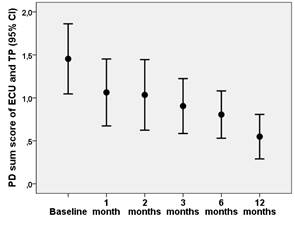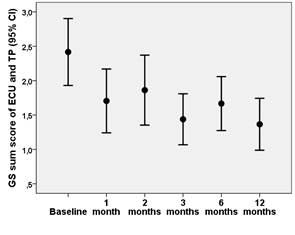Background/Purpose:
Ultrasound (US) (grey scale (GS) and power Doppler (PD)) is a sensitive tool for examination of tenosynovitis in patients with rheumatoid arthritis (RA). The extensor carpi ulnaris (ECU) and tibialis posterior (TP) tendons have been shown to be frequently inflamed in RA patients and improve during treatment. Even so, only few of the US joint scores include these tendons in disease assessments. The present objective was to examine by US the frequency of involvement of the ECU and TP tendons as well as explore their sensitivity to change during biologic medication.
Methods:
A total of 108 RA patients (aged mean (SD) 52.6 (12.9) years, 87% women, disease duration 7 (6) years, 84% anti-CCP positive) were consecutively included when starting biologic treatment (infliximab (n=17); etanercept (n=36); adalimumab (n=9); certolizumab (n=2); golimumab (n=5); rituximab (n=26); tocilizumab (n=8); abatacept (n=5)) and examined bilaterally by US of the ECU and TP tendons at baseline and after 1, 2, 3, 6 and 12 months (performed by HBH on Siemens Acuson Antares Excellence version, with standard setting throughout the study). Tenosynovitis was scored semi-quantitatively 0-3 for presence of GS and PD pathology. The frequencies of tendon involvement at baseline (percentage of patients) as well as the sum scores of GS and PD at all examinations were calculated, and the changes in US sum scores from baseline were explored by paired samples T-test.
Results:
The distribution of GS and PD scores of the ECU and TP tendons are shown in table 1. The sum GS and PD scores decreased significantly from baseline to all of the follow-up examinations (p≤0.001) as illustrated in figure 1.
|
Percentages of patients with tenosynovitis at baseline
|
||||||||
|
|
Extensor carpi ulnaris
|
Tibialis posterior
|
||||||
|
|
Grey scale
|
Power Doppler
|
Grey scale
|
Power Doppler
|
||||
|
Right
|
Left
|
Right
|
Left
|
Right |
Left |
Right |
Left |
|
|
Score 0 |
67 |
56 |
81 |
80 |
62 |
67 |
76 |
77 |
|
Score 1 |
18 |
21 |
7 |
9 |
19 |
15 |
11 |
10 |
|
Score 2 |
14 |
16 |
11 |
8 |
15 |
9 |
11 |
7 |
|
Score 3 |
1 |
7 |
1 |
3 |
4 |
9 |
2 |
6 |
Conclusion:
More than one third of the patients had GS synovitis and more than one fifth of the patients had PD activity in the ECU and/or TP tendons at baseline, and both GS and PD sum scores decreased significantly during biologic medication. The frequent involvement of the ECU and TP tendons as well as their sensitivity to change during treatment, support the inclusion of these tendons in models of joint scoring of RA patients on biologic medication.
Disclosure:
H. B. Hammer,
None;
« Back to 2013 ACR/ARHP Annual Meeting
ACR Meeting Abstracts - https://acrabstracts.org/abstract/ultrasound-shows-tenosynovitis-to-be-frequently-present-as-well-as-sensitive-to-change-in-ra-patients-on-biologic-medication/


